First things 1st, I am accustomed to larger cruising sailboats in which space and weight are nothing compared to this little canoe. In preparing for this adventure weight and space have been my primary concern and all modifications made on 'Robinson Calusa' had this in mind. I used the strongest materials reasonably available. In addition, materials such as laminating epoxy and Kevlar are more difficult and time consuming to deal with. So why did I take ten times what I needed on this voyage? Plain loco I guess...
Click here for the Building of 'Robinson Calusa'
Navigation in the Ten Thousand Islands and Everglades requires a keen sense of awareness. Never leave shore without good charts, compass, food and water. I memorized most of the major Islands the night before departure for that day, not all ten thousand of them! I could keep about ten islands or major river bends in my head without much difficulty then reference the chart for quick updates as I went along. The mangrove islands all look similar, I used geometry of the island/shoreline shapes to keep track and every hour or so place a dot with a perm marker on the chart. I had three sets of charts, one full size containing 100 charts in a kit of the entire West coast including the Keys, one copy of this scaled down for a 3 ring binder and one custom made with a small section of the chart on the left and a Google Earth aerial view of the same on the right. The dual chart/aerial was the best but I did use all three. I printed everything in color, placed in plastic page covers, and into a 3 ring binder. I also printed the camp information from Swamp Angle's fantastic site Everglades Diary on all the Everglades Wilderness Waterway campsites. My custom chart book with other information is 102 pages. I also have a handheld marine VHF radio for Coast Guard/Ranger contact if needed but mainly for the marine weather forecasts.

In addition to charts and compass I carried two handheld GPS's and
SPOT. SPOT is an acronym for Satellite Personal Tracker, I bought this device
when it first hit the market Nov 2007. It has both a GPS and satellite
transmitter contained in one small package. It works by receiving GPS
(your location) signals continuously and transmits them up to a
satellite when the OK button is pressed, but there is more.
It also has an alert '911' button for real emergencies. SPOT runs
about one month on two AA size Lithium batteries. I had three sets but
only needed the originals. The unit is $150 and requires a
subscription service, $100 for one year basic plus another $8 for
International, SPOT also offers a automatic tracking service for an
additional $50 but that requires password access to your personal
account to view so why?
I pressed the 'OK'button on the hour every hour and the messages were
sent out about 15 minutes later almost every time, a few were faster.
You can configure up to 10 email addresses to send. My wife, daughter,
and friends tracked the entire adventure. Cell phone service is only
available within about 10 miles of Flamingo at the South (AT&T,
Verizon) and Chokoloskee at the North (most services)...SPOT is the
missing link.
One word of caution - SPOT needs a very clear view of the sky, it did
not work under thick tree canopy or inside my tent where the GPS
worked fine.
The Garmin Legend C GPS worked great the entire voyage and did it
all on two sets of 2 alkaline batteries, back lighting off. I also had
an old Garmin eTrex Mariner packed away as a backup. I set the Legend
C to store the track information every tenth mile, it used about half
of it's memory. I also had all the campsites stored which helped a
little. It would have been ideal to have had the aerial views on the
GPS. There is one I know of that does just that but it has other
problems. Maybe next year...
Click here to see 'ALL' of the GPS track points!
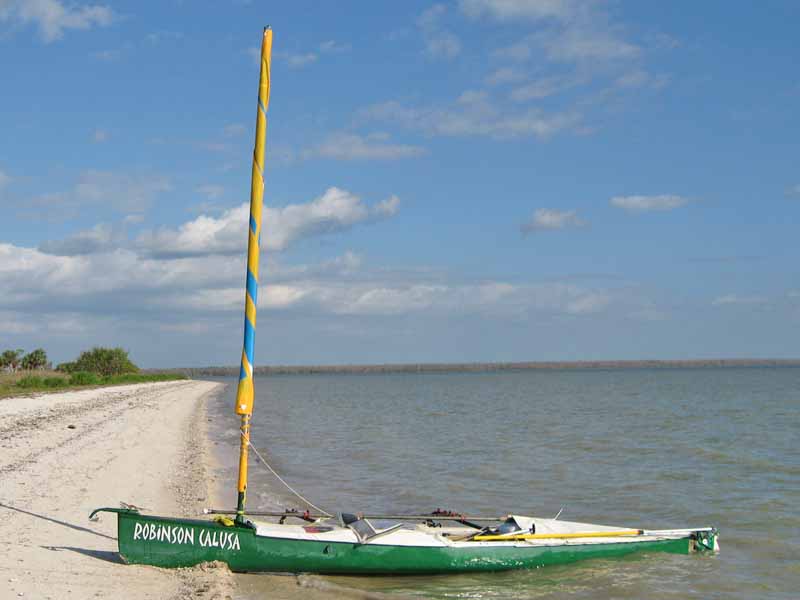
As you can see in this photo 'Robinson Calusa' was heavily loaded, dangerously so! I am really lucky that the strong winds on this adventure were all headed offshore. With all that weight I could only pull the bow a short way up the beach. I would then quickly unlace the covers and remove enough weight to pull it up further until it was all the way out of the surf zone, and I wounder why I have back problems. My Doctor thinks I'm crazy for attempting a trip like this. I had back surgery about 5 years ago and have had problems ever since. I take daily pain medication as it is. My take is that you only get one shot at life so I'll get out and challenge myself while I still can. Next adventure will be shorter and one tenth or less the weight of this one.
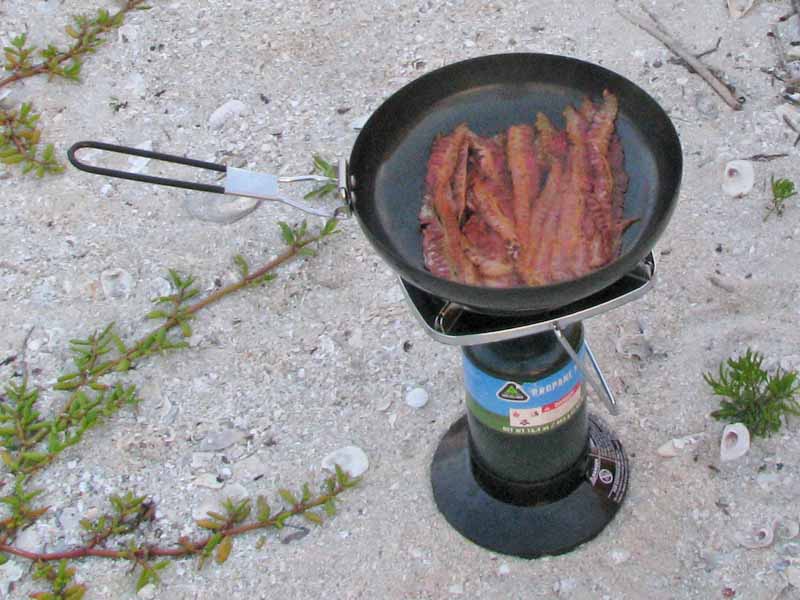
The small single burner propane stove worked perfect and was very hot even in the wind. I cooked eggs, pre-cooked bacon, and canned goods in it. The frying pan handle folds inside for compactness.
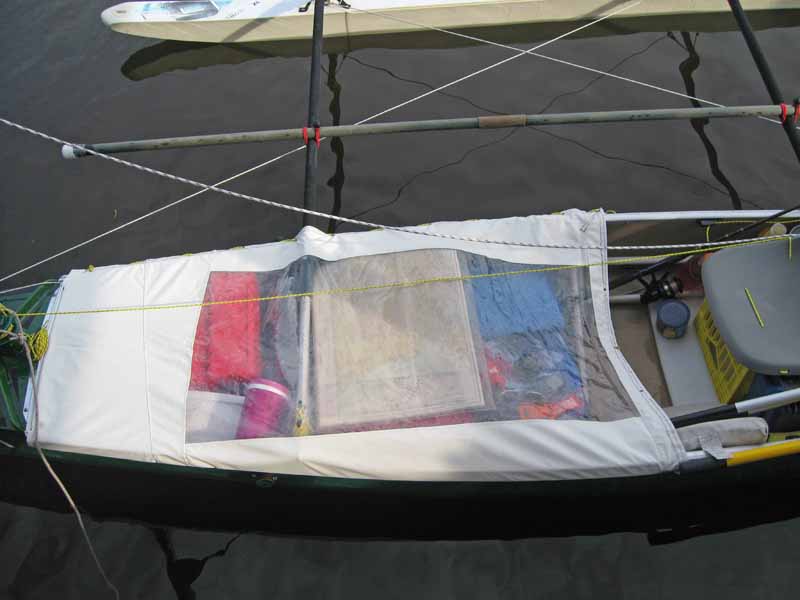
Loading the canoe was a backbreaking process and it left me with precious little room to move about. At least I had a seat and a view higher then most thanks to the outrigger for stability.
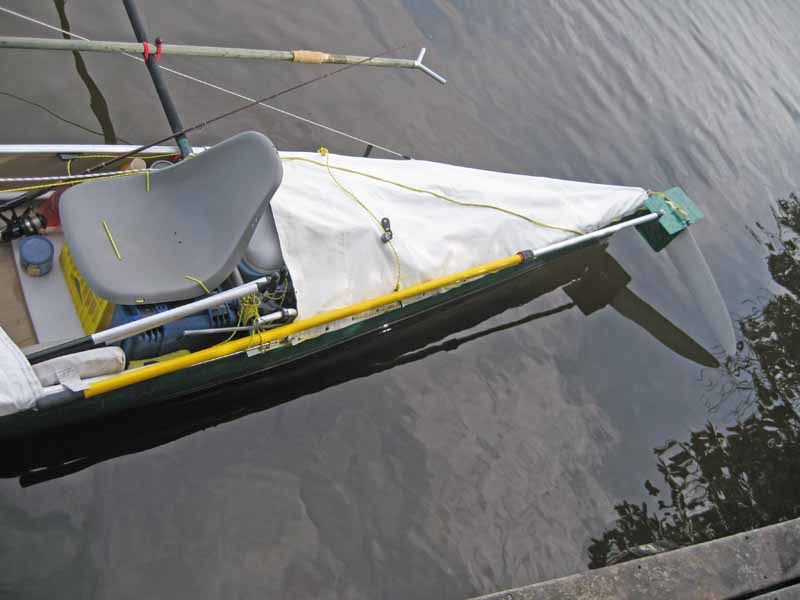
One thing I had not finished was stops for the rudder. As you can see in this photo the rudder can turn beyond 45 deg which becomes counter-productive. I also need a stop for it's forward swing - the kickup part. When a rudder has enough surface area forward of it's hinge axis it will be forced to one side or the other and stay there until the pressure is removed. In this case if I pulled the kickup rudder down to it's max it would swing to one side and act as a break. In a stiff breeze this not only stops forward progress but becomes dangerous as in breaking the rudder off or flipping the boat over.
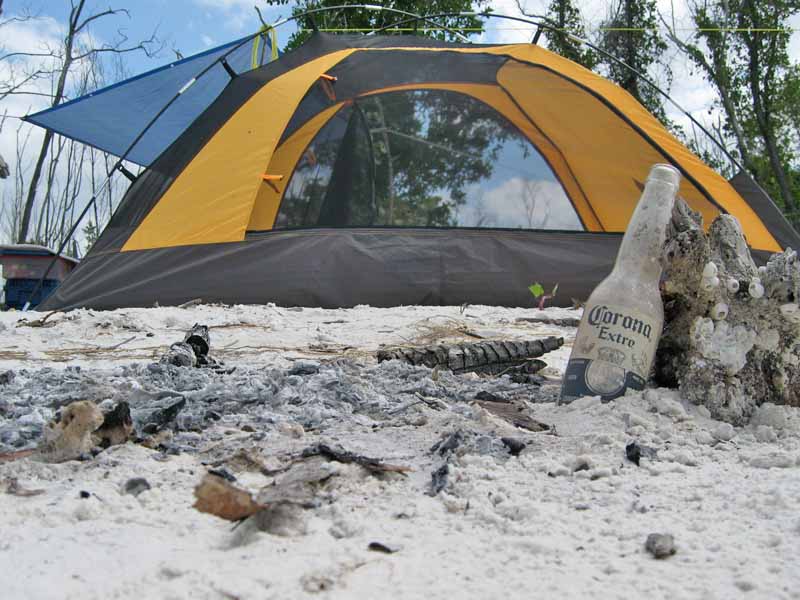
My tent is a Eureka Apex XT, it has fine mesh screen on three sides and two sides zipper open.
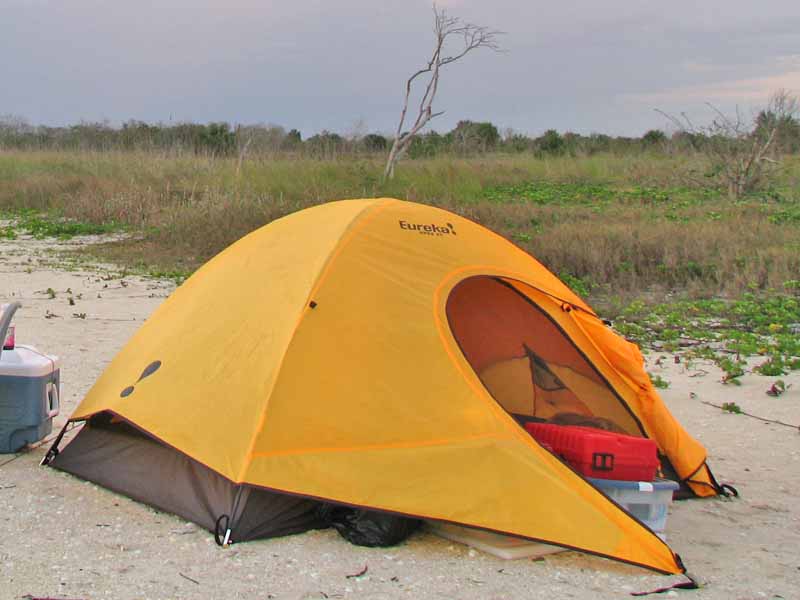
The Apex XT also has dual vestibules in the cover so either side can be used. I pulled the cover about half way up for a better view and block more of the sun on the beach sites, even so I still needed a tarp over that to keep from roasting during the cloudless days in the Florida Sun.

This is a typical daily water supply for the cockpit but I would not drink it all, just made available in my confined space.
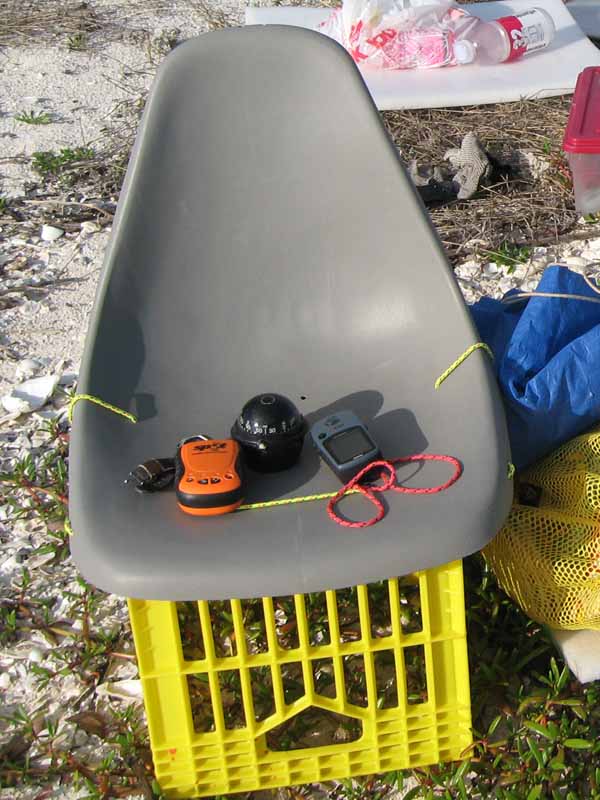
The seat was critical with my back problems. This setup worked quite well and had great back support except for the rough days on Starboard tack when I had to sit on the rail.

Two Sea Line 30L Sea Bags kept my clothes, sleeping bag, pillow, and therm-a-rest mattress dry. I like being able to see through them and not a drop inside. Under the bags you can see my canned goods supply in a cheap plastic container. This did get some water in when the boat flipped so I labeled the tops of the cans with a perm marker in case the paper labels fell off. To the far left you can just see the edge of a kitty litter container used to keep peanuts, bread sticks, crackers and a few other cardboard boxed items in. It sealed pretty well and was tall enough that no water made it inside. I really like this free container. It falls into the 5 gal bucket usefulness category.
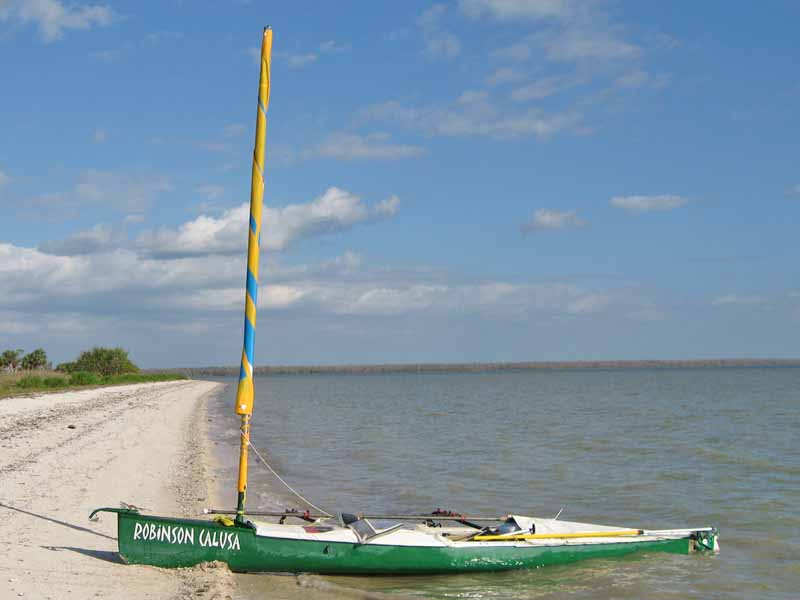
Here my tent is on top in a large electronic anti-static zip lock bag, it leaked...not recommended for a water tight bag. Under are three of my four Storm Cases. These are the strongest cases made and are fully waterproof, bought for my expensive camera gear not along on this trip. They are numbered in order of survival, I'd hang on to #1 at all costs! Survival items were in #1. #1 contained small first aid kit, VHF radio, knife, multi-tool, waterproof LED flashlights, matches, lighter, spare GPS, emergency strobe, whistle, compass, magnifying glass (to make fire), 100% DEET (for bugs), small water bottle, health food bars, spare batteries, meds, towel, shark bait...just joshing you, no shark bait!
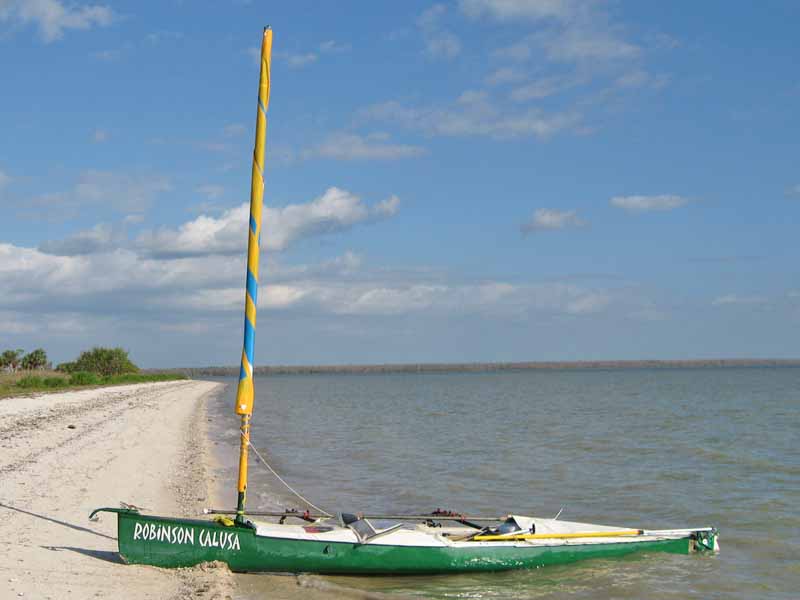
I had two pieces of the white foam seen on the bottom here. These came from some packing material and were very handy on the trip. I used them to sit on, set items on to keep clean or sand out of and they provided great floatation and protection for the boat. The yellow dive bag kept all the spare rope used for staking out the tarp and countless other uses, the blue/silver tarp is on top. Purple bag held bulky cold weather clothes that were also inside plastic bags. To the right are two canopy pole I found on Hog Key and reused then the GustBuster Umbrella. Garbage bags held both garbage and dirty clothes.
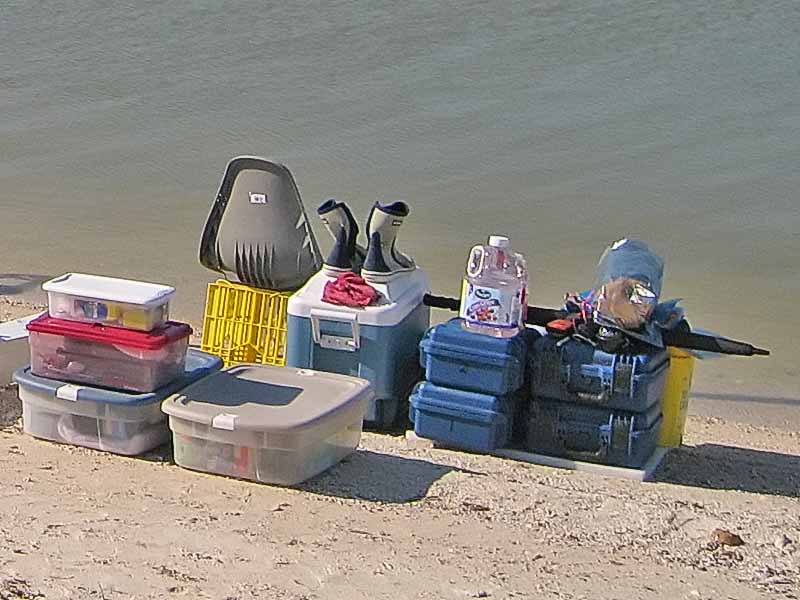
Here are most items on Highland Beach ready for loading. Each time a chore I did not relish.

You can see the canoe dolly frame sticking out here along with the two paddles. The wheels to the dolly are stored near the stern. Steve's push pole can also be seen in the foreground, I kept strapped to the aka's along with a rod and reel never used. I had little time to fish, besides I'm more into exploring then fishing, but if I needed some food I'd pull it out.
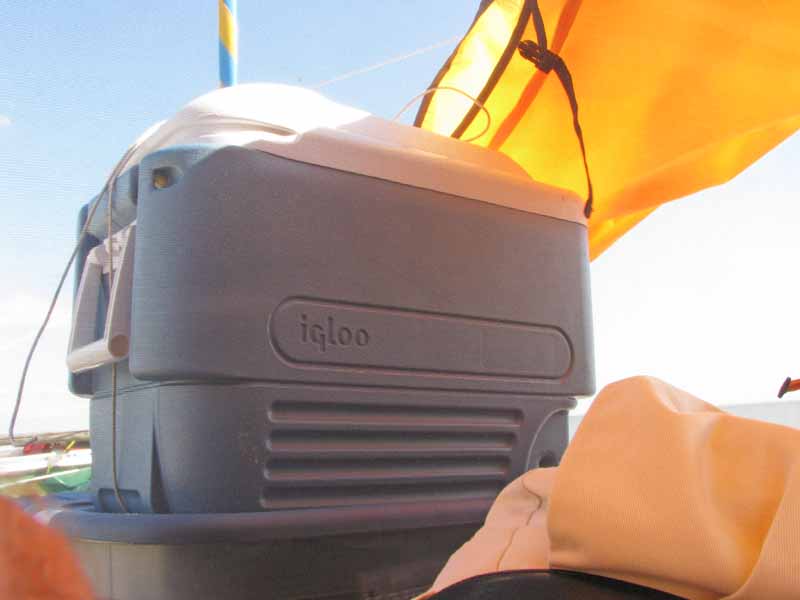
The 5 day Igloo cooler kept my frozen 3 gal water container for about 8 days. I was not in it much and I did have one cold night but I thought it did quite well considering all else.

My sailing boots came in handy when the bugs were really bad and they felt much safer when I had to walk the canoe gunwales putting the mast up/down while on the water.

Solar panels case. I had two solar panels which could be tied or set in many positions. They could charge my cell and camera batteries. It would take a full day of sunshine to charge 4-2500mA NiMh AA batteries and as it turns out I would have been OK without them. I would have been OK without 90% of what I had. Live and learn...I would rather have too much then too little...
email paul@paulsedwick.com - copyright (c) 2008 Paul Sedwick